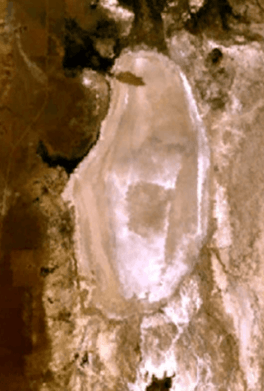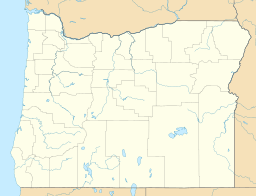Alvord Lake (Oregon) facts for kids
Quick facts for kids Alvord Lake |
|
|---|---|

Satellite image of Alvord Lake
|
|
| Location | Harney County, Oregon, U.S. |
| Coordinates | 42°22′47″N 118°36′20″W / 42.3796147°N 118.6054595°W |
| Type | seasonal, alkali |
| Primary inflows | Mosquito Creek, Willow Creek, Wildhorse Creek, Whitehorse Creek, Trout Creek, and Van Horn Creek |
| Catchment area | 2,150 sq mi (5,600 km2) |
| Basin countries | United States |
Alvord Lake is a unique lake located in Harney County, Oregon, USA. It's a "seasonal" lake, meaning it doesn't always have water. Sometimes it's completely dry, and other times it can be several feet deep.
This lake is also an "alkali" lake, which means its water has a high salt content. Alvord Lake sits at an elevation of about 4,026 feet (1,227 meters) above sea level. It's found about 10 miles (16 km) southeast of the Alvord Desert. All the streams in the area flow into Alvord Lake, making it their final stop. The closest small town is Fields, about 8.8 miles (14.1 km) to the southwest.
A Lake Through Time
Imagine a much bigger lake! Long ago, Alvord Lake was huge. It stretched for about 100 miles (160 km) along the eastern side of Steens Mountain. This shows how much the landscape can change over thousands of years.
The Alvord Basin
Alvord Lake is part of a larger area called the Alvord Basin. This basin covers a big space, about 2,150 square miles (5,570 square kilometers). It's surrounded by several mountain ranges:
- To the northwest, you'll find Steens Mountain.
- The Pueblo Mountains are to the southwest.
- The Trout Creek Mountains are located to the southeast.
- And to the northeast are the Sheepshead Mountains.
Many streams flow into Alvord Lake. These "tributaries" bring water from the surrounding mountains into the lake. Some of the main streams include:
- Mosquito Creek
- Willow Creek
- Wildhorse Creek
- Whitehorse Creek
- Trout Creek
- Van Horn Creek
The Alvord Cutthroat Trout
The streams that feed Alvord Lake were once home to a very special fish called the Alvord cutthroat trout. This fish was "endemic," meaning it was found only in this specific area and nowhere else in the world.
Sadly, the Alvord cutthroat trout is now considered "extinct." This happened because it mixed with other types of fish, like the rainbow trout, that were not native to the area. This mixing changed the unique Alvord cutthroat trout, and it no longer exists as its original species.
See Also



